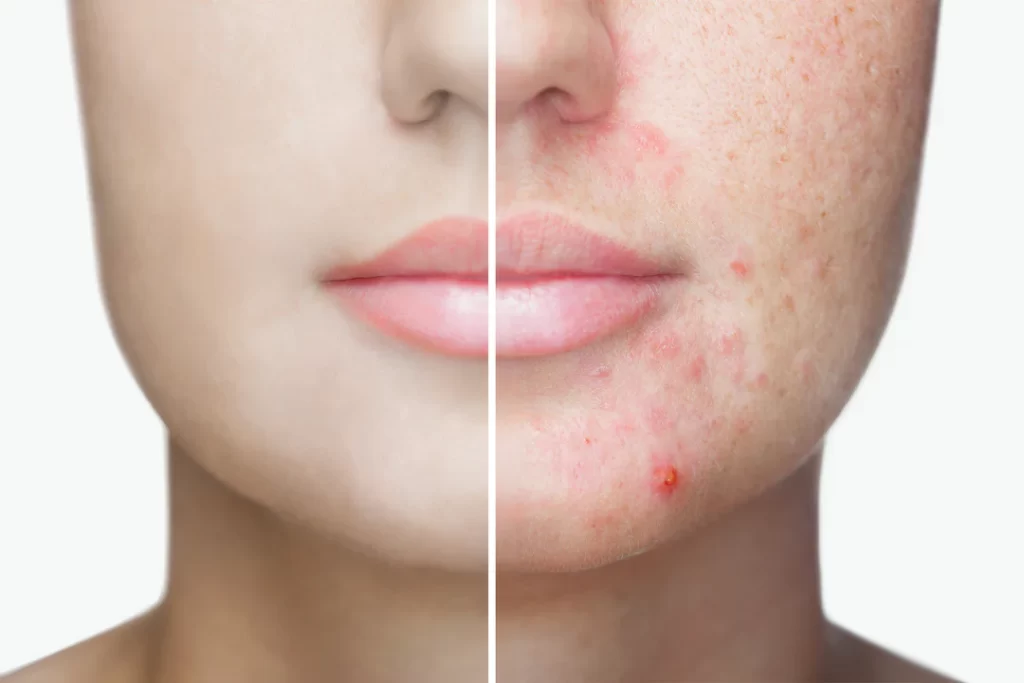
Which Ingredients Help Clear Acne?
Ingredients that help to clear acne work in a variety of different ways to keep the skin blemish free. With the market full of products ready to combat any forms of acne from cleansing lotion, gel, foams, leave on products, face masks, serums the list is endless, but which one is best? Which ingredients do you need to look out for? Let’s find out more.
Best ingredients for acne prone skin?
For over the counter (OTC) products there are a couple of ways they help treat and prevent acne. Some work at killing the bacteria that causes the blemish breakouts by clogging the pores, while others remove any excess oil from the skin and helps with the renewal of skin cells by speeding up the rate the layer of dead skin cells are removed. Whichever product you decide to use it is the active ingredients that deliver the results and we are going to explore their benefits in more detail.
Salicylic acid
Salicylic acid is a Beta hydroxy acid, BHA, and is able to work its way down into the lower layers of the skin, clearing out the pores of dirt, bacteria and excess sebum build-up that if left can cause an inflammation, such as spots or blackheads. You will be able to find salicylic acid in skincare products such as cleansers, serums, oils and moisturisers all of which need to contain an active amount of salicylic acid in them to provide the blemish fighting benefits you need. You can check the potency of the ingredient in a product by taking a closer look at the inky list on the packaging, if the acid appears lower down than 6th on the list the percentage is too weak to make any difference to the skin or acne flare-up.
Benzoyl peroxide
This ingredient helps to kill off any bacteria that causes acne and other blemishes by removing excess oil that can clog the pores whilst removing dead skin cells that would otherwise develop into spots and blemishes. In over the counter products you can find benzoyl peroxide strength levels varying from 2.5% to 10% and works best when it is applied regularly. Some side effects to look out for are redness, flaking, itchiness and dry patches on the skin.
Alpha hydroxy acids
Also known as AHAs these acids are an extended family of chemical exfoliants and are often used in products such as, cleansers, toners, serums and moisturisers. They work on the outer layer of the skin and slough dead skin cells by ungluing the bonds holding these cells together making it easier to reveal bright, vibrant new skin cells. The best AHAs to use on skin when you are wanting to clear acne are glycolic acid and lactic acid, both of which are great for all skin types to use and can clean the skin without causing too much dryness.
There is also the option of prescription treatments and medicines that can help with severe cases of acne as described on the NHS website which include the following;
Topical retinoids
Topical antibiotics
Azelaic acid
Antibiotic tablets
In women, the combined oral contraceptive pill
If you ever have any concerns with acne or how to treat it consulting your GP or dermatologist will give you some more clarity on the next steps to take when treating blemishes.
Best natural ingredients for acne?
For some cases of acne there is usually a connection with lifestyle and flare-ups, your first port of call when treating problematic skin is to take your skincare routine back to the basics and take a moment to look at your diet. To help improve your skin and treat any acne you can try the following;
Cut back on dairy, such as cheese and milk as this can have a noticeable effect on the clarity of your skin. Try going dairy-free for 2 weeks and make notes of how your skin is reacting and feeling, this will give you a good indication of your diet and how it was affecting your skin.
Exercising regularly will also help keep your skin clear as it promotes a healthy level of blood circulation which nourishes the skin and will help prevent acne and damage caused previously. Exercising also decreases stress and anxiety, both of which are huge culprits in contributing to acne flare-ups.
Exfoliating your skin regularly will keep it healthy and control any spots and blackheads. Using a scrub 2-3 times a week, depending on your skin type will buff away dead skin cells and bacteria build-up that are some of the main causes of acne.
There is also some other great natural ingredients to use when treating acne. You are able to use them in their raw form or blended into products that help treat and prevent breakouts.
Witch Hazel
Witch hazel is extracted from the bark of the witch hazel shrub and contains tannins which has powerful antibacterial and anti-inflammatory properties. Although there isn’t any scientific prove that shows it is an ingredient that can cure acne specifically there are many studies showing the benefits of applying witch hazel onto areas inflamed with breakouts that are reduced due to this ingredient combating bacteria, reducing any inflammation and aid any healing to the skin.
Tea Tree Oil
This potent extract is found from the leaves of Australian native trees, Melaleuca alternifolia, and has well established itself as a go to acne fighting ingredient with its impressive ability to reduce skin inflammation and battle against bacteria. Many studies have proven how effective 5% of tea tree in a formula can treat spots without causing too much dryness or irritation compared to other harsh ingredients. It is always advisable to dilute tea tree before using it on your skin, mix 1 part tea tree with 9 parts water to avoid any skin reactions.
What acids are good for acne?
Acids are the perfect addition to your skincare routine when you are wanting to target any problematic skin. Alpha hydroxy acids and Beta hydroxy acid both help to keep the skin looking and feeling its best and if used correctly can have a vibrant impact on your complexion. Here are some face acids that will benefit your skin and treat acne with ease;
Glycolic acid- This is a great starting acid for you to try if you haven’t used any previously. It is powerful at removing any dead skin cells but gentle enough not to cause any irritation or redness to the skin. Known as the most popular acid glycolic acid’s smaller molecule size allows it to penetrate further down into the skin and helps with a number of concerns, from boosting collagen production, diminishing fine lines and wrinkles and ensuring the skin doesn’t have a build-up of dead skin cells that often lead to breakouts.
Salicylic acid- As the only BHA available, salicylic acid has a large fan base due to its capability of working its way further down the skin compared to other AHAs and into the pores, clearing them of bacteria, dirt, excess oil and debris ideal for those who find their pores have become enlarged it can help minimise their appearance. It’s also a good idea to before patch test when using this acid as its strength can cause some irritation if overused or not introduced to the skin correctly.
Lactic acid- The beauty of lactic acid is that it delivers the same level of results as glycolic acid but has moisturising properties making it an acid that will benefit all skin types who experience some form of acne. With its great smoothing effect to the skin you can often find lactic acid is formulated into body care products, great for targeting any acne flare-ups on areas of the body, such as the back and chest.
If you are wanting to find out more about AHAs and BHAs you can check out our blog post about their benefits.
There you have the main ingredients you will find help to treat acne in the most effect way, ensuring you keep your skincare routine bespoke to your skin needs is key to having your skin look healthy with clarity and a smooth appearance. Overusing these acids, or exfoliating the skin too much will make strip it of any essential water and oils needed to keep the skin balanced and protecting its barrier. Always ensure you are hydrating the skin with serum packed with hyaluronic acid, vitamin C and ensuring you always apply a daily SPF of factor 30or above to prevent any sun damage.


